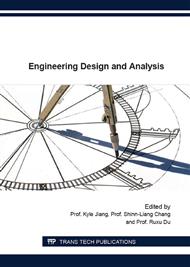[1]
N. Caterino, B. M. Azmoodeh, A. Occhiuzzi, Medium to long term behavior of MR dampers for structural control, Smart Mater. Struct. 23 (2014) 117005.
DOI: 10.1088/0964-1726/23/11/117005
Google Scholar
[2]
Z.D. Xu, Y.Q. Guo, Fuzzy control method for earthquake mitigation structures with magnetorheological dampers, J. Intel. Mat. Syst. Str. 17 (2006) 871-881.
DOI: 10.1177/1045389x06061044
Google Scholar
[3]
E.R. Wang, L. Ying, W.J. Wang, S. Rakheja, C.Y. Su, Semi-active control of vehicle suspension with magneto-rheological dampers: Part I - Controller synthesis and evaluation, Chin. J. Mech. Eng. 21 (2008) 13-19.
DOI: 10.3901/cjme.2008.01.013
Google Scholar
[4]
E.R. Wang, L. Ying, W.J. Wang, S. Rakheja, C.Y. Su, Semi-active control of vehicle suspension with magnetorheological dampers: Part II - Evaluation of suspension performance, Chin. J. Mech. Eng. 21 (2008) 45-52.
DOI: 10.3901/cjme.2008.02.045
Google Scholar
[5]
E.R. Wang, L. Ying, W.J. Wang, S. Rakheja, C.Y. Su, Semi-active control of vehicle suspension with magneto-rheological dampers: Part III-experimental validation, Chin. J. Mech. Eng. 21 (2008) 56-63.
DOI: 10.3901/cjme.2008.04.056
Google Scholar
[6]
M.G. Yang, C.Y. Li, Z.Q. Chen, Zheng-Qing, A new simple non-linear hysteretic model for MR damper and verification of seismic response reduction experiment, Eng. Struct. 52 (2013) 434-445.
DOI: 10.1016/j.engstruct.2013.03.006
Google Scholar
[7]
I. Fitrian, A. Saiful, M.Z. Hair, A design and modelling review of rotary magnetorheological damper, Materials and Design 51 (2013) 575-591.
DOI: 10.1016/j.matdes.2013.04.042
Google Scholar
[8]
B. Marek, L. Grzegorz, Transition to chaos and escape phenomenon in two-degrees-of-freedom oscillator with a kinematic excitation, Nonlinear Dynam. 70 (2012) 1125-1133.
DOI: 10.1007/s11071-012-0518-8
Google Scholar
[9]
S.M. Siewe, Resonance, stability and period-doubling bifurcation of a quarter-car model excited by the road surface profile, Phys. Lett. A 374 (2010) 1469-1476.
DOI: 10.1016/j.physleta.2010.01.043
Google Scholar
[10]
G. Litak, M. Borowiec, M. Ali, L.M. Saha, M.I. Friswell, Pulsive feedback control of a quarter car model forced by a road profile, Chaos Soliton Fract. 33(2007) 1672-1676.
DOI: 10.1016/j.chaos.2006.03.008
Google Scholar
[11]
C.J. Albert, L. Arun, Periodic motions and stability in a semi-active suspension system with MR damping, J. Vib. Control 13 (2007) 687-709.
DOI: 10.1177/1077546307074280
Google Scholar
[12]
I.H. Shames, F.A. Cozzarelli: Elastic and Inelastic Stress Analysis (Englewood Cliffs: Prentice Hall, 1992).
Google Scholar
[13]
M. Ismai, F. Ikhouane, J. Rodellar, The hysteresis Bouc-Wen model, a Survey, Arch. Comput. Methods Eng. 16 (2009) 161-188.
DOI: 10.1007/s11831-009-9031-8
Google Scholar
[14]
S.K. Baek, H.T. Moon, Complex hysteresis, Phys. Lett. A, 352 (1997) 89-93.
Google Scholar
[15]
S.B. Choi, B.K. Lee, Y.P. Park, A hysteresis model for the field-dependent damping force of a magnetorheological damper, J. Sound Vib. 245 (2001) 375-383.
DOI: 10.1006/jsvi.2000.3539
Google Scholar
[16]
H.L. Zhang, E.R. Wang, F.H. Min, S. Rakhej, and C.Y. Su, Semi-active sliding mode control of vehicle suspension with magneto-rheological damper, Chin. J. Mech. Eng. 26(2013) 498-505.
DOI: 10.3901/cjme.2014.0918.152
Google Scholar
[17]
G.I. Koumene Taffo, M. Siewe Siewe, Parametric resonance, stability and heteroclinic bifurcation in a nonlinear oscillator with time-delay: Application to a quarter-car model, Mech. Res. Commun. 52 (2013) 1-10.
DOI: 10.1016/j.mechrescom.2013.05.007
Google Scholar
[18]
F. Daniel, I. Rolf, Mechatronic semi-active and active vehicle suspensions, Control Eng. Pract. 12 (2004) 1353-1367.
DOI: 10.1016/j.conengprac.2003.08.003
Google Scholar


